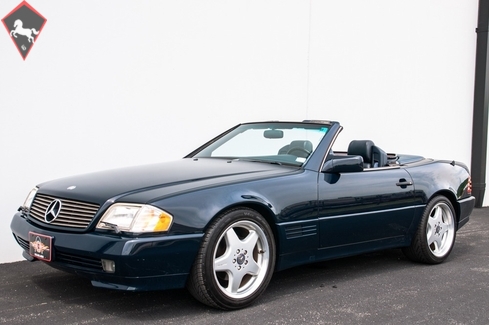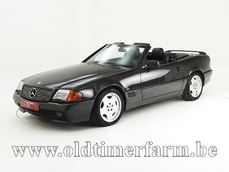Mercedes-Benz 500SL r129 V8 1990
General description :
1990 Mercedes-Benz 500SL Convertible
Same owner for the past 12 years
Dark Blue exterior (code DB-904) with matching electro-hydraulic folding top
Royal Blue Leather (code 272A) interior
M119 5.0L 32-valve DOHC V-8 engine
5G-Tronic five-speed automatic transmission with lockup torque converter
Power steering, power four-wheel disc brakes with anti-lock, windows, mirrors, locks and seats
Automatic roll bar and dual front airbags
Headlamp washers and wipers
Security system
Hardtop available from current owner
Chic, solid and a high number of standard features, MotoeXotica Classic Cars is pleased to offer this 1990 Mercedes-Benz 500SL (R129) Convertible. This example was made in November 1989 in Bremen, West Germany. We are selling this nice Mercedes 500SL for a local client of ours who has owned this car for the past 12 years and he mentions that the factory hardtop is also available.
Dressed in Dark Blue (code DB-904) with matching electro-hydraulic folding top, the paint and trim are in very good order, as are the windows, which are clear and intact, even the plastic rear windows. The cars lights are in overall very good condition, including the headlights, which have their own wiper blades and washers for cleaning.
This car rides on AMG, five-spoke alloy wheels, surrounded by 245/45ZR18 tires in front and 275/35ZR18 in rear. The right front wheel has a blemish on the trim ring. Its body panels are all solid and straight, including the body-matching collapsible roof, and bumpers. Driver convenience features include security system, automatic climate control, cruise control, power steering, power four-wheel disc brakes with anti-lock, dual front airbags, power windows, power locks, 10-way power seats with three-position memory, power mirrors and power antenna.
Designed in 1984, the R129 was based on the shortened floorpan of theMercedes-Benz W124and featured many innovative details for the time optional electronically controlled damping (Adaptive Damping System((ADS,)) optional) and a hidden, automatically extending roll bar. The number of standard features was high, with electric action for the windows, mirrors, seats and hydraulic convertible top. Other exterior features were removable wind deflector and ASR (Automatic Slip Control).
Under the 500SLs hood is aM1195.0L 32-valve DOHCV-8 engine. It had four valves per cylinder andvariable valve timingon theintakeside. The M119 offered the following features the engine block uses asbestos-free gaskets and has better oil flow; the cylinder head was afour-valvealuminum unit withdual overhead camshafts; the connecting rods are forged and enable cooling of the pistons with sprayed oil; the pistons are iron-coated cast aluminum; an improved vibration damper system is used; the aluminum oil pan has bolted-on oil baffles to prevent foaming of the engine oil; the intake camshaft timing is adjustedhydro-mechanicallyup to 20°.
The M119 engine is linked to aMercedes-Benz 5G-Tronic is an electronically shifted five-speed overdrive automatic transmission with torque converter lockup.
Other vehicle features include front suspension with independent struts with separate coil springs and gas-pressurized shock absorbers, triangular lower control arms with anti-dive geometry and stabilizer bar.
Out back is an independent five-arm multilink suspension with separate single-tube gas-pressurized shock absorbers and coil springs, geometry for anti-lift, anti-squat and alignment control and stabilizer bar.
Inside, the Royal Blue Leather (code 272A) interior is in very good overall condition. The bucket seats look fantastic. The matching carpet is in similar good condition while there is a light colored headliner that is in good order. The car comes with full VDO instrumentation and the dashboard looks great. The original four-spoke steering wheel is present and the door panels match the rest of the interior. The mirror glass, center console and shifter are all in very good order. Rounding out the interior is a factory AM/FM stereo with cassette deck.
Competition to this Mercedes in 1990 included Chevrolets Corvette Convertible, Jaguars XJ-S V12 Convertible, Ferraris Mondial T Convertible, Lotus Ãlan SE and Mazdas RX-7 Convertible.
This car is currently located at our facility in St. Louis, Missouri. Current mileage on the odometer shows 93,425 miles. It is sold as is, where is, on a clean and clear, mileage exempt title. GET OUT AND DRIVE!!!
VIN: WDBFA66EXLF004747 EIN: 119960 12 003303 TIN: 722353 03 313621 GA Type
http://www.motoexotica.com/inventory/listing/1990-mercedes-benz-500sl-convertible/
1990 Mercedes-Benz 500SL r129 V8 is listed sold on ClassicDigest in Fenton (St. Louis) by for Not priced.
Car Facts
Car type : Car Make : Mercedes-Benz Model : 500SL r129 Model Version : V8 Engine size : 0.0 Model Year : 1990 Sub type : Convertible Location : Fenton (St. Louis)
Sold
Seller Information
Sold
People who viewed this Mercedes-Benz 500SL r129 also viewed similar Mercedes-Benz listed at ClassicDigest
Other cars listed for sale by this dealer
About Mercedes-Benz
In the annals of automotive history, the journey of Mercedes-Benz is a tale that unfolds with the ingenuity of its founding pioneers. In the year 1886, Karl Benz crafted the Benz Patent Motorwagen, a creation that would go down in history as the world's inaugural automobile. Unbeknownst to him, this moment marked the genesis of what would evolve into the most illustrious premium car manufacturer globally. The financial underpinning of this pioneering venture, interestingly, was provided by Karl Benz's wife, Bertha Benz, demonstrating a remarkable partnership that would set the tone for Mercedes-Benz's legacy.A parallel narrative emerged not far away, as Daimler-Motoren-Gesellschaft, founded by Gottlieb Daimler and Wilhelm Maybach, entered the scene. In 1901, they unveiled their automobile under the now-famous moniker "Mercedes," meaning "godsend" in Spanish. This name was bestowed upon the car at the behest of Emil Jellinek's daughter, the distributor for Daimler-Motoren-Gesellschaft. The wheels of innovation were set in motion.
Fast forward to 1926, a pivotal year that witnessed the merger of Daimler with Benz & Cie., culminating in the birth of Daimler-Benz. The amalgamation saw the adoption of "Mercedes-Benz" as the distinguished trademark for their automobiles, fusing the legacies of two visionary entities into one.
Contrary to perceptions of conservatism, the trajectory of Daimler-Benz unfolds as a chronicle of industry firsts. From the introduction of the honeycomb radiator to the float carburetor, and the pioneering implementation of four-wheel brakes in 1924, Daimler-Benz consistently pushed the boundaries of automotive innovation. The diesel-powered Mercedes-Benz 260 D in 1936 marked the inception of diesel engines in passenger cars. The iconic Mercedes-Benz 300SL Gullwing made history as the first car with direct fuel injection, albeit the Gutbrod's tiny 2-stroke engine can claim precedence.
Safety innovations became a hallmark, with Béla Barényi's patented safety cell design in the "Ponton"-models in 1951, featuring front and rear crumple zones. The W116 450SEL 6.9 saw the introduction of the Anti-Lock Brake system (ABS), another pioneering safety feature. From the first production airbags and beyond, the legacy of "firsts" continued to be etched into the fabric of Daimler-Benz.
Over its centennial journey, Mercedes-Benz has not merely produced cars but has sculpted automotive icons. The SSKL, 710 SSK Trossi Roadster, 770K Grosser, 540K Spezial Roadster, 300SL Gullwing, w100 600 Pullman, w111 280SE 3.5 Flachkühler, w113 230SL Pagoda, w109 300 SEL 6.3, and w201 2.3-16 Cosworth stand testament to the brand's commitment to engineering excellence.
The roaring Silver Arrows, or "Silberpfeile," including the W 25, W 125, W154, W165, and W196, created a legacy of dominance on the racetrack. These machines were not merely cars; they were expressions of precision, speed, and an indomitable spirit that left their competitors in the dust.
As Mercedes-Benz marches into the future, it does so not just as an automaker but as a custodian of a legacy, a torchbearer of innovation, and a beacon of automotive excellence. The road ahead is sure to witness the continued fusion of cutting-edge technology, timeless design, and an unwavering commitment to setting new standards in the world of automobiles.
One luminary figure who left an indelible mark was Béla Barényi, often heralded as the "father of passive safety" for his pioneering work in safety engineering. His patented safety cell design, featuring front and rear crumple zones, became a hallmark of Mercedes-Benz's commitment to occupant safety, setting new standards that reverberated throughout the automotive world.
Moving through the chronicles, the collaborative genius of Wilhelm Maybach, alongside Gottlieb Daimler, laid the foundation for Daimler-Motoren-Gesellschaft. Their innovations not only birthed the first Mercedes but established a culture of relentless pursuit of technological excellence that remains integral to Mercedes-Benz's DNA.
In the post-merger era of 1926, Ferdinand Porsche emerged as a prominent figure within Mercedes-Benz. His work on the Mercedes-Benz S-Type, a supercharged race car, garnered acclaim and set the stage for a legacy that extended far beyond the marque. Porsche's impact would later extend to his eponymous company, but his influence at Mercedes-Benz during those formative years was pivotal.
As the 20th century progressed, the legendary Rudolf Uhlenhaut emerged as a key figure. Uhlenhaut, an accomplished engineer and the driving force behind the iconic Silver Arrows, played a crucial role in Mercedes-Benz's dominance in motorsports. His engineering prowess and attention to detail were instrumental in creating some of the most formidable racing cars of the era.
In the latter half of the century, figures like Bruno Sacco, the head of design at Mercedes-Benz from 1975 to 1999, left an indelible imprint on the brand's aesthetic identity. Sacco's design philosophy, characterized by clean lines and timeless elegance, shaped iconic models like the W126 S-Class and the W201 190E, solidifying Mercedes-Benz's reputation for luxury and sophistication.
The narrative would be incomplete without acknowledging the contributions of engineers like Hans Scherenberg, whose leadership in the 1970s ushered in a new era of technological innovation at Mercedes-Benz. Scherenberg's tenure saw the development of groundbreaking technologies, including the Anti-Lock Brake system (ABS) and the introduction of airbags in production cars.












